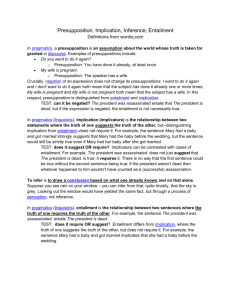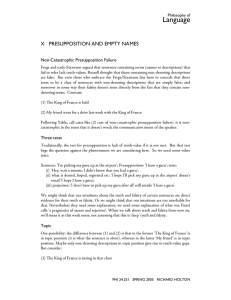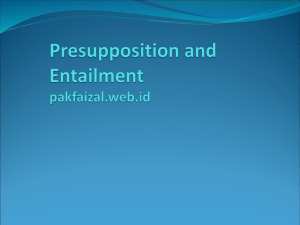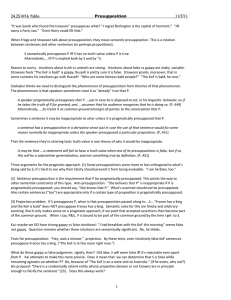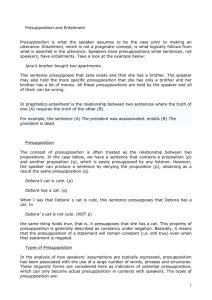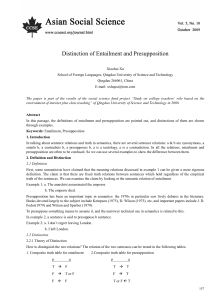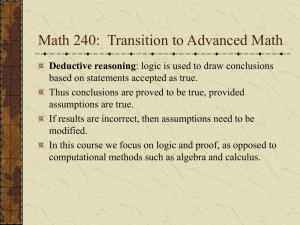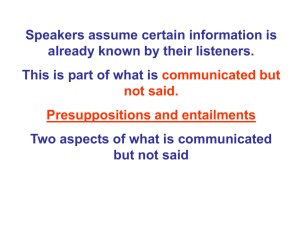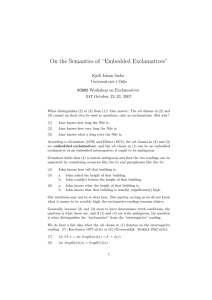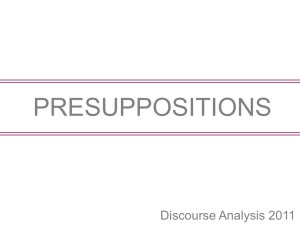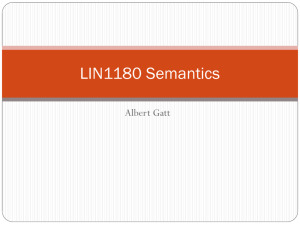Linguistics 3430
advertisement
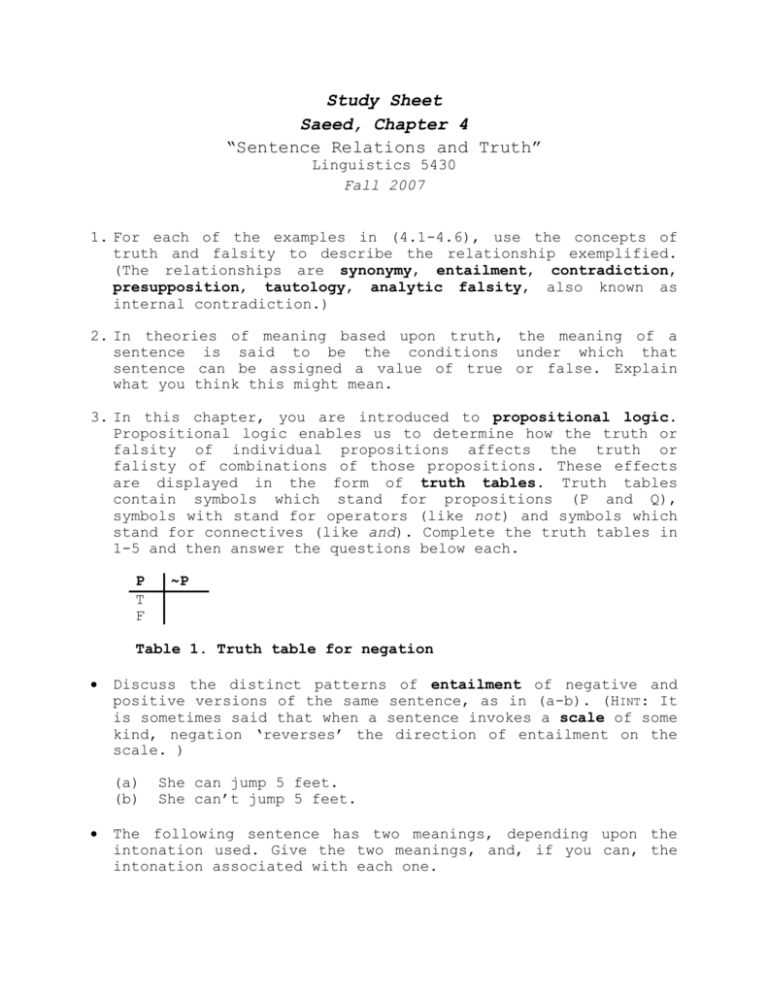
Study Sheet Saeed, Chapter 4 “Sentence Relations and Truth” Linguistics 5430 Fall 2007 1. For each of the examples in (4.1-4.6), use the concepts of truth and falsity to describe the relationship exemplified. (The relationships are synonymy, entailment, contradiction, presupposition, tautology, analytic falsity, also known as internal contradiction.) 2. In theories of meaning based upon truth, the meaning of a sentence is said to be the conditions under which that sentence can be assigned a value of true or false. Explain what you think this might mean. 3. In this chapter, you are introduced to propositional logic. Propositional logic enables us to determine how the truth or falsity of individual propositions affects the truth or falisty of combinations of those propositions. These effects are displayed in the form of truth tables. Truth tables contain symbols which stand for propositions (P and Q), symbols with stand for operators (like not) and symbols which stand for connectives (like and). Complete the truth tables in 1-5 and then answer the questions below each. P T F ~P Table 1. Truth table for negation Discuss the distinct patterns of entailment of negative and positive versions of the same sentence, as in (a-b). (HINT: It is sometimes said that when a sentence invokes a scale of some kind, negation ‘reverses’ the direction of entailment on the scale. ) (a) (b) She can jump 5 feet. She can’t jump 5 feet. The following sentence has two meanings, depending upon the intonation used. Give the two meanings, and, if you can, the intonation associated with each one. 2 (a) She didn’t move to San Francisco because her mother lived there. P Q T T F F T F T F P Q & Table 2. Truth table for conjunction It is generally said that when you reverse the order of the two propositions in a sentence of the form P&Q, this reversal does not affect the meaning of the sentence. Give an example in which reversal (i.e., Q&P) WOULD affect the meaning of the sentence. Give a propositional logic representation of the following sentence: (b) She didn’t buy strawberries and motor oil. Might this sentence actually have more than one propositional logic representation? P Q T T F F T F T F P Q Table 3. Truth table for disjunction The truth value that you have to fill in the first row of Table 3 might have surprised you. Take an ordinary sentence containing disjunction and briefly explain why in an ordinary context you would not likely interpret it as asserting the truth of BOTH P and Q. Give a propositional logic representation of the following sentence: (a) She didn’t buy strawberries or motor oil. 3 Might this sentence be ambiguous (i.e., propositional logic representation)? P Q T T F F T F T F P Q have more than one Table 4. Truth table for material implication Look at the third row of Table 4 (after you have filled it in). Take an ordinary sentence containing if and briefly explain why in an ordinary context you would interpret the if as meaning only if. Does material implication involve a condition sufficient, necessary, or necessary AND sufficient? What problem does Saeed see this truth table presenting for the analysis of counterfactual sentences? P Q T T F F T F T F P Q that is Table 5. Truth table for the biconditional Does the biconditional operator describe a condition that is sufficient, necessary, or necessary and sufficient? 4. Create a sentence that describes a truth necessary and analytic, but not a priori. which is both 5. Which of the three varieties of truth pertains to the way in which we gain knowledge? To the way that the world is? To the newsworthiness of an assertion? 6. The definition of presupposition includes both entailment and negation. Explain. 7. What is the difference between an approach to presupposition failure based upon truth gaps and the one that Russell advocates? In particular, think about Russell’s contention 4 that the sentence The present king of France is bald is You might want to make reference to the analysis in 4.77. FALSE. 8. The salesperson in Macy’s, while ringing up my purchase, asks me Will you be using your Macy’s card today? I don’t own a Macy’s card and I therefore feel rather uncomfortable. Which theory of presupposition, the truth-based theory or the interactional theory, would do a better job describing what’s going on in this situation? 9. In addition to definite nominals, there are several other linguistic expressions that give rise to presuppositions. These are called presupposition triggers. For each of the following sentences, describe what the presupposition is and what the trigger is: a) Have you stopped beating your dog? b) It’s the color that really bothers me. c) She cleaned up the kitchen before we came over. d) I regret saying that. e) Which wine did you sample? f) She accused me of talking to you. 10. Give an example (other than one in the text) in which a presupposition fails to project to the sentence as a whole. 11. Give an example (other than defeasibility of a presupposition. one in the text) of 12. Give an example (other than one in the text) in which you force your hearer to accommodate to your presupposition.
